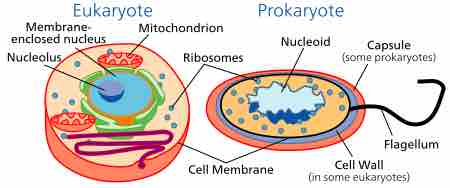Characteristics of Eukaryotic DNA compared to Prokaryotic DNA
Prokaryotic cells are known to be much less complex than eukaryotic cells since eukaryotic cells are considered to be present at a later point of evolution. It is probable that eukaryotic cells evolved from prokaryotic cells. Differences in complexity can be seen at the cellular level.
The single characteristic that is both necessary and sufficient to define an organism as a eukaryote is a nucleus surrounded by a nuclear envelope with nuclear pores. All extant eukaryotes have cells with nuclei; most of a eukaryotic cell's genetic material is contained within the nucleus. In contrast, prokaryotic DNA is not contained within a nucleus, but rather is attached to the plasma membrane and contained in the form of a nucleoid, an irregularly-shaped region that is not surrounded by a nuclear membrane .

Cellular location of eukaryotic and prokaryotic DNA
Eukaryotic DNA is stored in a nucleus, whereas prokaryotic DNA is in the cytoplasm in the form of a nucleoid.
Eukaryotic DNA is packed into bundles of chromosomes, each consisting of a linear DNA molecule coiled around basic (alkaline) proteins called histones, which wind the DNA into a more compact form. Prokaryotic DNA is found in circular, non-chromosomal form. In addition, prokaryotes have plasmids, which are smaller pieces of circular DNA that can replicate separately from prokaryotic genomic DNA. Because of the linear nature of eukaryotic DNA, repeating non-coding DNA sequences called telomeres are present on either end of the chromosomes as protection from deterioration.
Mitosis, a process of nuclear division wherein replicated chromosomes are divided and separated using elements of the cytoskeleton, is universally present in eukaryotes. The cytoskeleton contains structural and motility components called actin microfilaments and microtubules. All extant eukaryotes have these cytoskeletal elements. Prokaryotes on the other hand undergo binary fission in a process where the DNA is replicated, then separates to two poles of the cell, and, finally, the cell fully divides.
A major DNA difference between eukaryotes and prokaryotes is the presence of mitochondrial DNA (mtDNA) in eukaryotes. Because eukaryotes have mitochondria and prokaryotes do not, eukaryotic cells contain mitochondrial DNA in addition to DNA contained in the nucleus and ribosomes. The mtDNA is composed of significantly fewer base pairs than nuclear DNA and encodes only a few dozen genes, depending on the organism.